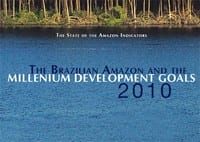 Celentano, D., Santos, D., & Veríssimo, A. 2010. The Brazilian Amazon and the Millenium Development Goals 2010 (p. 85). Belém: Imazon.
Celentano, D., Santos, D., & Veríssimo, A. 2010. The Brazilian Amazon and the Millenium Development Goals 2010 (p. 85). Belém: Imazon.
The Millenium Development Goals, established by the UN in the year 2000.
Propose specific targets and indicators for measuring and guiding improvement in socioeconomic (poverty, education, health, gender equality, and maternal and infant mortality) and environmental conditions in poor and developing regions of the world. In this State of the Amazon, we evaluate the evolution of these objectives in the context of Brazilian Amazon up to 2009 in relation to the targets proposed for 2015 by using 25 indicators.
In the Brazilian Amazon there has been progress in relation to the majority of the indicators when comparing its situation in the year 2009 to 1990. But overall this improvement is still unsatisfactory and the region remains below the national average. The Amazon situation is critical in the case of poverty, the incidence of malaria, AIDS, maternal mortality and access of the population to water and sewer service.
The progress was modest as to seeking gender equality. The women have little participation in politics and receive less than men (for the same job and qualifi cations) in the labor market. Furthermore, the region has maintained high violence indicators. Moreover, the indigenous peoples and the other traditional populations face great challenges in ensuring their well-being.
There is progress in the education fi eld (nevertheless, improving the quality remains a challenge); there was no inequality between the sexes in access to school while infant mortality fell (despite underreporting in the official statistics). The region advanced considerably in creation of protected areas (indigenous lands and conservation units) from slightly more than 8% in 1990 to about 44% of the territory in 2010. In addition, deforestation fell markedly in recent years and in 2010 reported its lowest rate in recent history.
Among the 15 targets evaluated in this study, only one was fulfi lled in the region (eliminating inequality between the sexes in childhood education). If this slow pace is maintained, only two other goals will have been reached by 2015: guaranteeing access to fundamental education and reversing the loss of environmental resources, measured herein by reduction of deforestation and gradual expansion of protected areas.
Baixe aqui o arquivo
